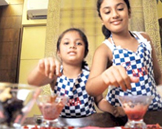Creative Corner
Nuclear Energy, Nation’s Energy
By- Saumya Lawankal
Nuclear Energy is the energy that is released from the nucleus of an atom, as it is evident from the term nucleus. During the process, mass get converted into energy. Although there are three ways from which the nuclear reactions are possible – fission, fusion and decay, only the energy from the first one has been utilized till date.
The process to generate nuclear energy is one of the ...
Read More
By- Saumya Lawankal
Nuclear Energy is the energy that is released from the nucleus of an atom, as it is evident from the term nucleus. During the process, mass get converted into energy. Although there are three ways from which the nuclear reactions are possible – fission, fusion and decay, only the energy from the first one has been utilized till date.
The process to generate nuclear energy is one of the cleanest processes and makes lowest impact on the environment. Nuclear plants do not emit any harmful gases like carbon dioxide, nitrogen oxide and sulpher dioxide, produced by the conventional electricity power plants that threaten atmosphere by increasing global warming. The energy can hence, be termed as ‘emission-free-energy’. They require little space for the production, thus promoting land and habitat preservation. There is absolutely no effect on land, water and air resources.
The water discharged from the nuclear power plants is very safe and is free of radiation or harmful pollutants and meets all regulatory standards. Hence, it helps in protecting the aquatic life and conserving wildlife.
One utmost importance of nuclear energy is reliability. The energy doesn’t have to depend upon the weather conditions, unpredictable costs or foreign suppliers. It’s a reliable source of energy.
There have been great advances in using nuclear energy for peaceful purposes, such as medicinal use of isotopes and radiation techniques. One major ongoing advancement is Sterile Insect Technique (SIT),that helps in large scale food irrigation and biological control of pests.
The use of isotopes and radiation techniques in agriculture come under this category. Leading organization has been working on this technology to increase agriculture production, improve food availability and quantity, reduce production costs and minimize pollution of the food crop.
One very common application of nuclear energy is in the treatment of cancer radiotherapy. Also, small towns of radioisotope tracers are used for diagnostic and research purposes. These techniques have helped in monitoring the level of substances in air, food and water.Nuclear Substances can also be used in industries for processing and sterilization of various products by means of radiation.
To conclude, nuclear energy has enormous benefits, but its upto humans to use it safely, and for the peaceful purposes.
Note : Student is the Ist prize winner from BPS, Bilaspur in Eassy Writing competition conducted by Media and Research Foundation in support with Nuclear Power Corporation of India Limited.
Gol Ghar and the Champa Kali Man
By Shuchita Prakriti
“Gol- Ghar†…. A picture of a huge hollow cement ball with a slanting roof perched on top and a lot of doors and windows all around, appeared before my eyes as I and my mother waited for an auto-rickshaw on that traffic-filled afternoon in Patna. But when we reached Gol Ghar, I found that it was nothing like what I had imagined. It was a huge neglected-looking grey dome with a set of...
Read More
By Shuchita Prakriti
“Gol- Ghar†…. A picture of a huge hollow cement ball with a slanting roof perched on top and a lot of doors and windows all around, appeared before my eyes as I and my mother waited for an auto-rickshaw on that traffic-filled afternoon in Patna. But when we reached Gol Ghar, I found that it was nothing like what I had imagined. It was a huge neglected-looking grey dome with a set of stairs coiling all around it like a vine.
There was no ticket, so directly we started climbing the steep, tightly coiling stairs covered with paan stains and a litter of gutka pouches, cigarette butts and discarded bits of paper that had some time contained snacks. I noticed that my drab jeans and short hair were attracting attention in the crowd of girls like me dressed in elaborately embroidered colourful kurtas, chunnis and jewellery. So wriggling out of the slow-moving crowd and leaving my mother puffing her way up, I ran to the top and came face to face with the Champa Kali Man.
The top of the dome was surrounded on three sides by a small chimney-like parapet, and exactly in the centre of the enclosure stood a thick waist high pillar, on top of which the Champa Kali Man had spread his wares – long, stiff sweets shaped like bread-sticks or twisted like cheese straws. Mom, who loves traditional and disappearing stuff, immediately bought a big packet, and began chatting with him. Gallant and chatty, the Champa Kali Man immediately became a friend. When mom tried to take a picture of me, he rushed up with his candyman’s bell and asked me to pose with it. He was so sure he was doing the best thing under the circumstances, that it was as funny as it was irritating. He also called me ‘babu’ – that was the first of many times in Patna that I was mistaken for a boy.
When mom suggested that she take a picture of him, the Champa Kali Man immediately pulled me into the frame as well, still bell in hand, and struck a dashing pose with a stick of champa kali in one hand and making a victory sign with the other. Later he presented me with an extra free sweet.
On our way down, we tried to eat our Champakalis – they are basically a thick cluster of jaggery syrup strings drawn and twisted around a brittle bread-like core – and choked on their oversweetness, which made us laugh even more. However, around us grown ups and children were buying and eating the sweets with every sign of enjoyment. Out on the road, I said I simply could not stand the sweet any longer. Mom immediately threw her sweet over her shoulder, and I did the same. Then we walked on, planning about distributing the remaining sweets to all our friends and relatives as souvenirs from Patna…..
About the author:
Full Name : Shuchita Prakriti
Age : 15
School : Home-schooled (does not go to school)











